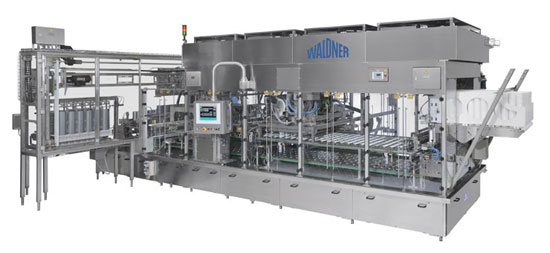The DOSOMAT Success Story — An Interview with Managing Director Karl Angele
High-performance, reliable, unique — you could use these three words to define a DOSOMAT filling and closing machine. WALDNER has enjoyed great success for over 60 years with this machine and, in recent years, turnover has grown from just under £40 million to over £60 million. Why do so many customers put their trust in WALDNER filling systems? What is so special about DOSOMATS? And are there finite limits when it comes to customers‘ requirements? We wanted to get to the bottom of this success story and so approached the Managing Director of Hermann WALDNER – Karl Angele:
Mr Angele, you understand DOSOMAT systems better than anyone else in the company. You‘ve been working in this division for 40 years and were personally involved in the evolution of these machines. What makes WALDNER DOSOMATS so successful?
I think that our success can be attributed to several factors. Firstly, we are a down-to-earth, well-organised medium-sized company that has been in existence for over a century and has always been owner-managed. This is an incredible factor in terms of stability, something that is very beneficial to a company of our size and something that our customers greatly appreciate. In addition, we have been manufacturing filling and closing machines for over 60 years. We understand our customers‘ problems and develop the appropriate solutions to solve them. No one has more experience than WALDNER! This wealth of experience and the professionalism of our employees are further factors that customers really appreciate about our company. They know that they have a reliable partner in WALDNER, a company that understands the industry and its needs. However, there‘s also a lot of luck involved – with the benefit of hindsight I realise that we did a lot of things correctly by intuition.

You have supplied over 3,000 of these machines worldwide that are currently in operation with customers. How do you organise the delivery of spare parts or repairs?
We are proud of the fact that international corporations, like Kraft Foods (Philadelphia), Nestlé, Unilever, Bongrain, Hochland, Karwendel (Exquisa), General Mills, the Mars Group and also Campbell – to name but a few – use DOSOMATS to fill their products. Of course, we also have to guarantee these customers global customer service. We have fitters here in our factory for this, who immediately attend to customers if faults occur and we also have partners on the ground, who can be with customers within a very short space of time. What is more, as far as possible we aim to hold all common spare parts in stock so that we can ensure a fast delivery.
Nevertheless, your customer base doesn‘t just consist of global corporations, but a number of smaller food producers or cheese dairies as well. How can you meet these different needs: on the one hand large-volume production with precise filling and fast packaging and, in contrast, reliable output, minimal space and manual work?
That is precisely one of our unique strengths: we design and build machines with a large range of capacities. The small DOSOMAT 1.1 is a rotary machine producing up to 6,000 cups. By contrast, our largest system, the DOSOMAT 20.48 , fills over 100,000 cups per hour on 48 lines. So, as you can see, we have the right solution in our range for every customer.
The media are forever discussing the issue of shelflife. How do DOSOMATS help with a product‘s shelf-life and how is the shelf-life of a product filled by a WALDNER system improved?
We have three methods for ensuring aseptic filling: We equip the inline or rotary machines with a UVC lamp that uses UV radiation to sterilise the cups. The latest technology that we use for sterilisation is the UVC flash light (pulse light) and, as standard, we often still sterilise our packaging with H2O2 (peroxide). Customers can select the method that works best for them and, for our part, we guarantee reliable hygienic processing and a longer shelf-life
How do you deal with the needs of customers who wish to operate several product lines on one system? Is that even possible? And, if so, what are the preconditions?
As this is a major concern for our customers, we design the systems in such a way that they can run as many product lines on them. We call this solution “format change“. All our machines can be equipped with a quick-change system, by means of which the formats can be swapped quickly and easily. This format change can also be done fully automatically. Several formats are already mounted on the machine and are then placed in position using servo technology.
Why are DOSOMATS fully electronically equipped with servo motors today and no longer with mechanical motion?
We wouldn‘t be here today, where we are now, without modern servo technology in the controllers for our DOSOMATS. Our customers expect maximum flexibility from us. Servo technology enables us not only to achieve maximum system speed, but it means that we can also service a system or run software updates remotely. It is important that customers can operate the system as far as possible themselves, to keep our work to a minimum and save them money. We were also able to use servo technology to develop an intuitive user interface that aids the simple operation of the system. None of this would have been possible with the mechanical motors of the past, especially not that packaging systems have ever-increasing dimensions, as is so often the case. That‘s why we switched to this technology over ten years ago. Today, 100% of all DOSOMATS and end packaging systems run with servo technology.
By birgit.burger@waldner.de
Show moreShow Less
Show more...Show Less